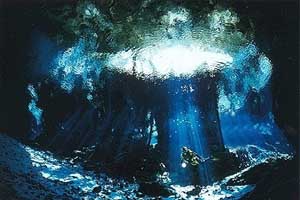
Cenote diving near Tulum, Quintana Roo, Mexico.
Part 3. Caves of Tropical Latin America
Compared to the USA, caves of Latin America are wonderfully
unregulated. Some can only be entered with a commercial tour during the day, but
are not guarded at night. Others can be explored freely by anyone. Please be careful
- cave ecosystems are very fragile.
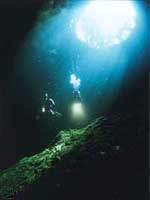
Diving into a cenote, Quintana Roo. |
The most famous type of caves unique
to Tropical America are cenotes, flooded sinkholes. They exist in Belize,
Florida, on Cuba, the Bahamas, and some other Carribean Islands, but most of them
(thousands) are on Yucatan Peninsula, Mexico. (Most cenote pictures on this page
are by Aktun Dive Center, reproduced with
permission). Tulum area of Quintana Roo is the best place to try cenote diving. |
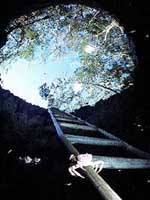
Cenote entrance, Quintana Roo. |
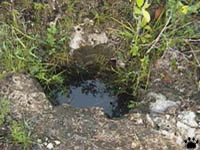
Micro-cenote, Sian Ka'an, Quintana Roo. |
Cenotes differ in size from tiny, less
than 1 m wide, to huge sacred lakes up to 500 m in diameter. Many have underground
connections, so you can dive from one to another, or even float downstream into
the sea. |
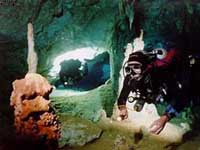
Cenote diving near Tulum, Mexico. |
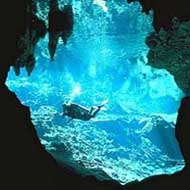
Cenote diving near Tulum, Mexico. |
Diving there is also a chance to see
spectacular termoclines, nice formations, unusual fauna, and sometimes ancient
artefacts, from Maya sacrifices to mammoth bones.

Brotula cave fish in a cenote, Quintana Roo. |
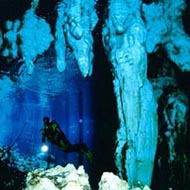
Cenote diving near Tulum, Mexico. |
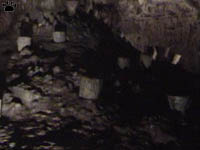
Ancient Maya offerings, Balancache Cave, Yucatan. |
Mexico has more caves than any other
country in Latin America. Some, such as caves of Baja California,
are interesting for their cultural importance, others are absolutely unique. |
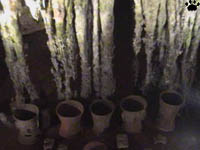
Ancient Maya offerings, Balancache Cave, Yucatan. |
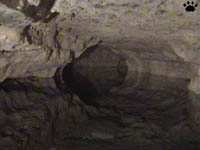
Underground river, Balancache Cave. |
Many caves of Yucatan Peninsula were
used as sacred sites by the ancient Maya. Some have large bat colonies, but
not as huge as in bat caves of Cuba, Puerto Rico, or in Grutas de Lonquin of nearby Guatemala. |
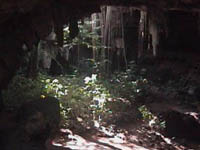
Entrance to Grutas de Lotun, Yucatan. |
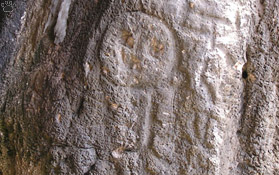 |
 |
| Caves of the Dominican Republic have thousands of Taino Indian petroglyghs. Left, Cuevas El Pommier; right, Cueva de Maravillas. Here's more. |

Pteronotus parnellii
bat, Cueva de Sardines,
Tabasco, Mexico. |
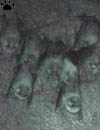
P. personatus bats,
Grutas de Lonquin,
Guatemala. |
Most "bat caves" of Latin
America have thousands of Pteronotus bats and are very hot and humid, especially
if the bats are disturbed and start flying around. |
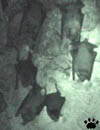
P. gymnonotus
and P. davyi bats,
Cueva de Sardines. |
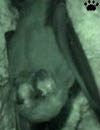
Mormoops
megalophylla bat,
Cueva de Sardines. |

Fishing bats (Noctilio leporinus) in a small cave, Parque Nacional Jaragua, Dominican Republic. |
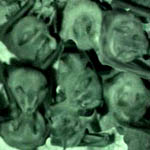
Artibeus lituratus bats,
Cueva de Sardines. |
The most unique bat cave of the Western
Hemisphere is a medium-size cave known as Cueva de Sardines or Cueva de Villa
Luz, in Tabasco state near Chiapas border. This cave is in a relatively remote
area, and is seldom visited by tourists. It has a few hundred thousand bats, belonging
to more than thirty species, some of them very rare. |
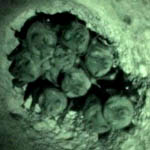
Platyrrhinus helleri bats,
Cueva de Sardines. |
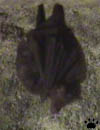
Anoura geoffroyi bat,
Cueva de Sardines. |
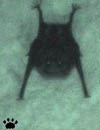
Saccopteryx bilineata
bat, Cueva de Sardines. |
But high bat diversity is not what
makes it so unique - some South American caves have up to forty species of bats.
Cueva de Sardines is the World's only sulphur cave. |
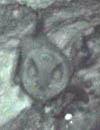
Sturnira lilium bat,
Cueva de Sardines. |
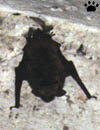
Molossus ater bat,
Cueva de Sardines. |
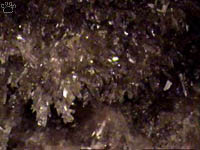
Cueva de Sardines. |
The walls of the cave are covered with
sulphur-processing bacteria. The microbes create splendid mineral formations,
resembling glass coral, weird fungae, or gemstones. |
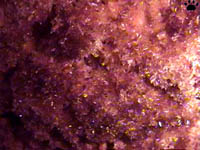
Cueva de Sardines. |
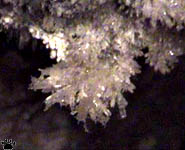
Cueva de Sardines. |
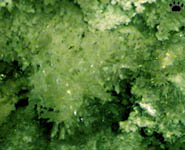
Cueva de Sardines. |

Snottites, Cueva de Sardines. |
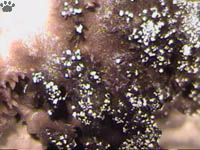
Cueva de Sardines. |
A small river flowing through the cave
has high sulphuric acid content. But it is also rich with organic material from
bacterial films and bat droppings, so it is full of life. |

Cueva de Sardines. |
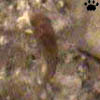
Adult fish,
Cueva de Sardines. |
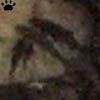
Spawning fish,
Cueva de Sardines. |
Tiny fishes are so numerous that local
people use them for food. It is probably the World's most productive cave ecosystem. |

Water bug with eggs on
its back, C. de Sardines. |

Transparent shrimp,
Cueva de Sardines. |
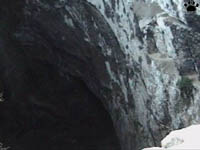
Sotano de las Guiguas is the smallest of the two,
but it is still too large to photograph. |
San Luis Potosi state has two largest
sinkholes in the World: Sotano de las Golondrinas and Sotano de las Guaguas. They
are 300+ m deep; people actually sky-dive in them. Both shelter thousands of swifts
and parakeets. |
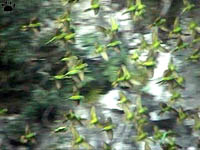
Green parakeets (Aratinga holochlora),
Sotano de las Golondrinas. |
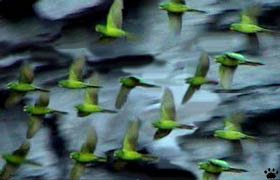
Green parakeets (Aratinga holochlora), Sotano de las Golondrinas. |

Cave centipedes, unnamed cave near Palenque, Chiapas. |
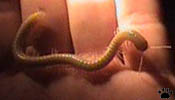
Cave millipede, unnamed cave, Nicaragua. |
Neotropical caves contain countless
animals, plants, fungae, and microbes. Nobody knows how many new species are hiding
in huge cave systems of South and Central America. |

Cave millipede, Grutas de Lotun, Yucatan. |
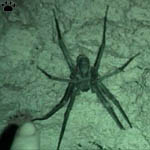
Wolf spider, Cueva de Raton, Belize. |
Only a handful of South American caves
have ever been visited by biologists, and almost none have been studied thoroughly.
Venezuela, Brazil, Colombia, Ecuador, Peru and Bolivia have thousands of caves
awaiting their first explorers. Among the more accessible cave systems are Jumandi
Caves in Ecuador, known for huge concentrations of vampires and other bats. |
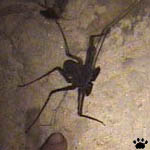
Whip spider, Grutas de Lotun. |

Vampire (Desmodus rotundus), Jumandi
Caves. |
Beautiful La Concha Cave in Peru also
has a lot of bats, but it is among the most inaccessible ones, being located near
remote Fitzcarraldo Pass in Manu Nat'l Park. This area is closed for tourists
and has no native people. |
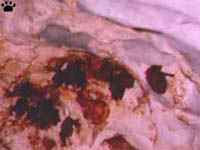
Assorted bats, La Concha Cave, Peru. |
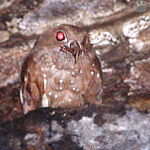 |
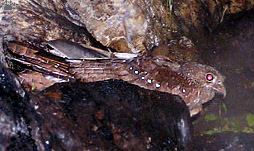 |
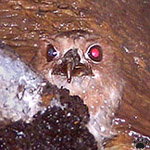 |
| Oilbirds (Steathornis caripensis) in a cave on Mt. Roraima, Venezuela. |

Ancient cave burial,
Nazca Plateau caves, Peru. |
Caves of the dry parts of South America
are mostly of interest for archaeologists. Many small caves of Peru and Bolivia
contain ancient mummies and other types of burials, some Brazilian caves have
nice cave paintings. Cueva de Los Manos in Argentina has palm prints of ancient
people, believed to be at least 10,000 years old. Further South, Cueva de Milodon
near the Southern tip of the continent was probably used as a shelter for semi-domesticated
giant sloths. |
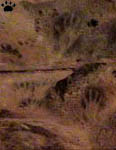
Ancient palm prints,
Cueva de los Manos. |

Drapery, Cueva Chica, Colombia. |
Part 4. Caves of Europe and Northern Asia
Back to Part 2
Home
|